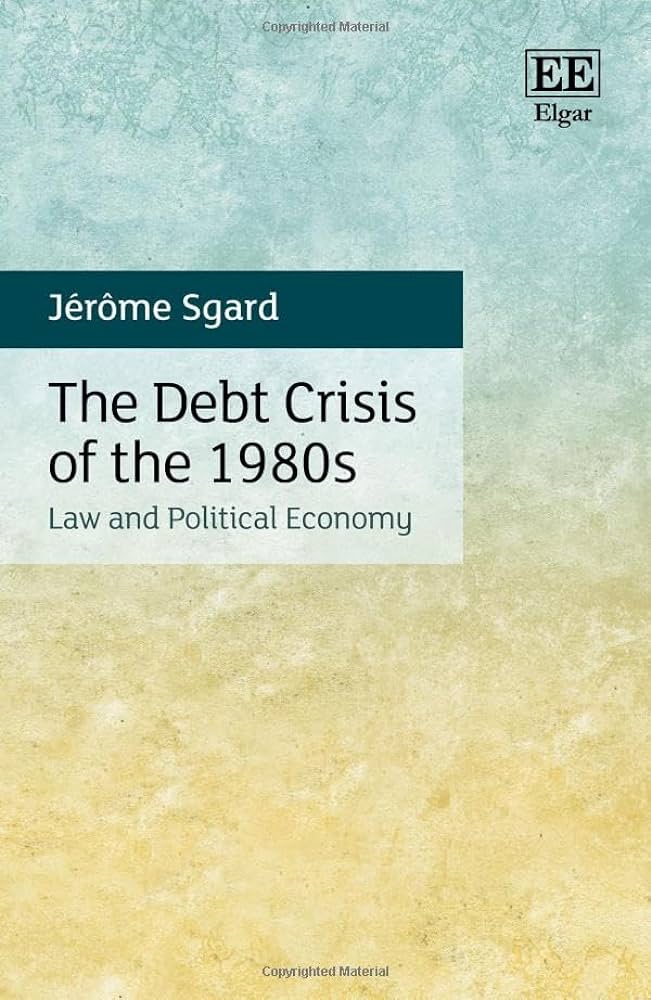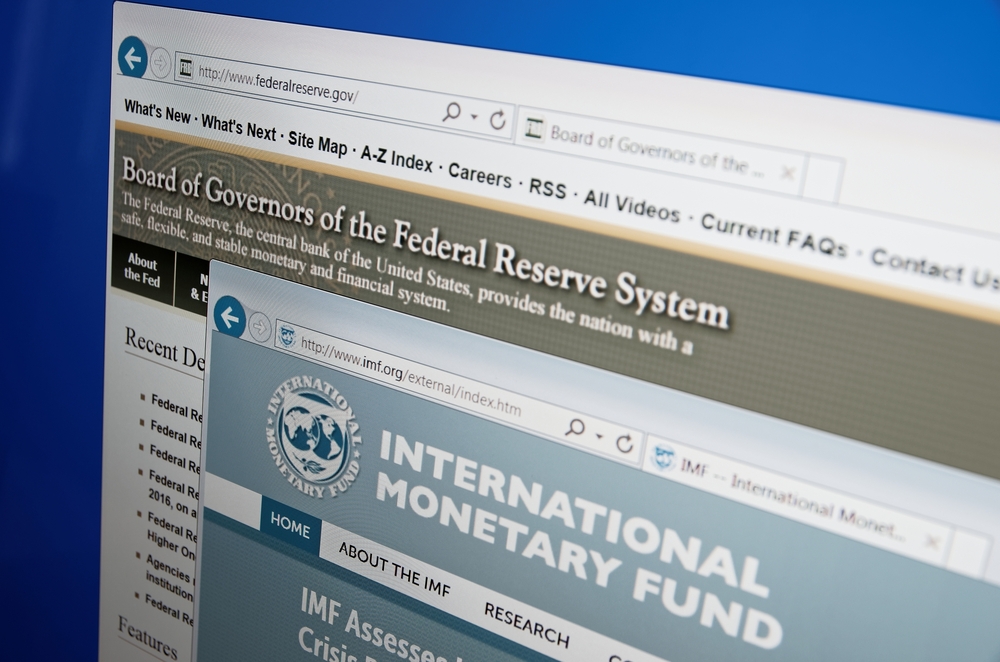The 1980s debt crisis, an incinerator of past policies & an incubator of the global turn? Interview with Jérôme Sgard

Professor Jérôme Sgard is the author of The Debt Crisis of the 1980s:Law and Political Economy (Edward Elgar, December 2023), in which he offers a novel account of the major debt crisis that hit developing countries during the 1980s. The whole episode was sparked by a spectacularly flawed cycle of bank lending, during the 1970s. The open crisis started with the quasi-default of Mexico, in 1982, and was only resolved in 1989-92, with the so-called Brady Initiative. Jérôme answers our questions about how governments and international institutions (the International Monetary Fund in particular) dealt with it at the time. We also discuss why this crisis has not been much studied, even though it also sheds a strong light on current issues of international financial governance.
In the introduction of your book, you note, as a reason for your inquiry, that very little has been written on the 1980s debt crisis since it was resolved, around 1989-1992, but, at the same time, that this crisis has a significant place in the long history of globalization and international finance. Can you expand on this?
Indeed, this crisis should have a prime place in economic and financial history! If you look back over the two last centuries, only the financial crisis of the 1930s was clearly larger than that of the 1980s: more countries stopped servicing their debt, more debt remained unpaid, and the resolution also took way more time in the former case. Beyond these two cases, you only have a series of more local episodes, which does not mean they were not serious: the Ottoman empire famously defaulted in 1875, Argentina followed suit in 1892 and, much later, of course, you have the euro-crisis of the early 1990s, for instance. But, indeed, the 1980s are largely forgotten. The usual phrase—“the lost decade”—tells it most clearly: why on earth would you spend time researching a crisis that seemingly has nothing to tell us about sovereign debts, crisis management, or the experience of financial multilateralism?
How do you explain this disinterest of economic historians and political economists?
We are probably in a kind of intermediary phase: today’s debt practitioners and researchers typically know little about the experience of the 1980s, especially the younger ones, while historians have not yet entered this terrain. It’s a kind of no man’s land, which is, incidentally, a key reason why I thought it would be interesting to spend a few years on the story! But I also think that the dramatic changes of the early 1990s, at the global level, both political and financial, weigh on this state of affairs. I’m thinking here about the ascent of global markets, financial deregulation, the Washington Consensus, market reforms in Eastern Europe, etc. For many authors, it seems that the 1980s were more important for what came next than for what happened at the time.
In many ways, the 1980s marked the end of the post-war decades, which were marked by state-led development, import substitution, regulated capital movements, various forms of social corporatism, and so on.
Today’s collective myopia vis-à-vis this episode probably reflects in part a cognitive distance regarding the policy approaches of those times, and more generally how public-private relations were structured. Monetary policy was also conducted very differently than it is today, banking regulations were nearly inexistent with regard to international lending, etc. In no region more than in Latin America, which was at the core of the debt crisis, was this break with the previous policy consensus larger. This is still very well remembered today, and resented in a large part of public opinion and among political elites.
Is this what you call the “incinerator” dimension of the 1980s?
 Yes indeed. I could have also quoted again the famous sentence by Gramsci, when he says that the “crisis consists precisely in the fact that the old is dying and the new cannot be born”. But this quotation has been overused; it’s more of a cliché today! That being said, it would be wrong to conclude that debt killed the developmentalist consensus. The Latin American growth regime had been in serious trouble since the late 1960s, as underlined by high inflation, low productivity growth, fiscal crisis, social polarisation, and so on. Even without the debt crisis, Latin America would have had a hard time reforming its economic model during the 1980s. What probably happened is that the big debt cycle of 1975-1982 gave a last lease on life to the old growth model, for instance in Brazil or Mexico, before making reform more difficult, and more brutal. Structural reforms implemented in a hurry, under intense external pressure, cannot be very promising. But it is not evident either that the democratic elites who took power across the continent, in the middle of the decade, had a clear model and strategy in mind. So, there was a lot of confusion and little room for experimentation.
Yes indeed. I could have also quoted again the famous sentence by Gramsci, when he says that the “crisis consists precisely in the fact that the old is dying and the new cannot be born”. But this quotation has been overused; it’s more of a cliché today! That being said, it would be wrong to conclude that debt killed the developmentalist consensus. The Latin American growth regime had been in serious trouble since the late 1960s, as underlined by high inflation, low productivity growth, fiscal crisis, social polarisation, and so on. Even without the debt crisis, Latin America would have had a hard time reforming its economic model during the 1980s. What probably happened is that the big debt cycle of 1975-1982 gave a last lease on life to the old growth model, for instance in Brazil or Mexico, before making reform more difficult, and more brutal. Structural reforms implemented in a hurry, under intense external pressure, cannot be very promising. But it is not evident either that the democratic elites who took power across the continent, in the middle of the decade, had a clear model and strategy in mind. So, there was a lot of confusion and little room for experimentation.
But, interestingly, whereas the debt crisis clearly opened the way for the massive changes of the following decades, it was also very much addressed with old-style, post-war, interventionist strategies. The IMF and the US government, and more generally the G7 governments, were much more heavy-handed vis-à-vis international banks than they are today, or have been since the early 1990s. They intervened in the debt contracts and restructured them in a very top-down manner, with pretty little attention to formal issues of jurisdiction, rule of law, or procedural guarantees. Today, this “Colbertist” approach would be entirely unimaginable.
You underline however that the methods for addressing the 1980s debt crises were not only very interventionist: quite often they were not made public at all…
To start with, in those years, the economic programmes negotiated with the IMF were generally kept secret by the governments themselves—today, they are all immediately published on the IMF website. More important, I think, is how a large part of crisis management remained informal and secret. The book insists in particular on the acute problems of collective actions among mostly Western lending banks. Hundreds of them were typically party to each debt restructuring – and many countries restructured twice or thrice over the decade. The problem is that all the larger banks had a stake in the recovery and expansion of international markets; some even had a substantial retail network in some countries. But the smaller banks, who may have stupidly taken a share in the last collective loan to Mexico or Argentina, in the early 1980s, just wanted to take their losses and drop out of the negotiation. If that had happened, the whole burden of crisis management may have gradually fallen on the largest banks only. So, they resisted that outcome and constantly arm-twisted their smaller colleagues so as to make sure every single bank would play its part in “sharing the burden” of the crisis. And if they failed, the national central banks and the minister of finance stepped in and corralled the wayward banks.
Yet this coercive machinery, which was fully articulated to the IMF decision-making process, could not be publicly acknowledged: both these muscular methods and the criticism voiced by countries like Germany or the Netherlands, never came to the surface. Nearly all academic researchers missed this dimension of contestation and tensions within the Western financial and policy elites. Moreover, few paper archives have remained from this side of crisis management. The US Federal Reserve for instance was the last resort enforcer when “disciplining” the US banks. After I identified the person who had been in charge, in Washington, I asked twice to access his files, following the Freedom of Information Act. But both applications were rejected, ultimately in the name of sovereign prerogatives. Apparently, forty years afterwards, not everything regarding the 1980s debt crisis can be shared with the public.
How does this “old-style” dimension of crisis management reflect on the relationships between creditor and debtor countries, North and South?
This was still the time of the old, dominant West: American supremacy was uncontested; European countries clearly deferred to the United States on the big issues; and the likes of China and India, not to mention Turkey or Brazil, were nowhere to be heard in the broader political and economic debate. Imagine also that, over thousands of pages of archives, including IMF archives, I did not find any trace of a single seminar where debt negotiators from developing countries could have shared their experiences and exchanged advice. This was a no-go zone. A French official even warned his colleagues against a “debtors commune”, the reference here being the 1871 uprisings in Paris (see page 151 of the book)! In practice, the collective experience and know-how drawn from each country case was accumulated and kept by the lawyers who advised governments, as they negotiated on their debt.
When reading the literature on the 1980s, one regularly finds reference to a “Cartagena conference”, or a possible “Cartagena consensus”. What can you tell us about this?
Two conferences of Latin American countries were actually organized in 1984, first in Quito, in Ecuador, and then in Cartagena, in Colombia. The explicit aim was to agree on a common position of debtor countries, vis-à-vis the United States, the G7, and the IMF. But these conferences led nowhere. Apparently, the whole project was doomed, right from the beginning, by the divergence between countries that wanted to preserve working relationships with creditor countries and other, more radical ones: for example, Mexico and Argentina respectively. The whole initiative hardly registered in Washington. It was never perceived as a tangible threat to the ongoing restructuring process and did not even re-emerge in the latter half of the decade, which was arguably harder socially and politically than the first half.
This is one of the greatest paradoxes of those years: the relationships between debtor countries and creditor ones, or their banks, never truly threatened the restructuring game, contrary to the relationships between banks, with all the arm-twisting machinery. There was surely a dimension of political domination, though the governments of debtor countries also kept a strong interest in finding a solution to the crisis and normalising their position vis-à-vis the rest of the world. Outright refusal to negotiate, or repudiation, are extremely rare events in the history of sovereign debts. Governments may of course contemplate this option—this is in the nature of the situation. But they would then ask what they would do the day after, or the year after—and no convincing answer is available at this point. Even during the 1930s, when capital markets and the international political order had collapsed, not a single country repudiated. And of course, at a time when creditor banks and creditor countries were extremely well organised, as in the 1980s, this willingness of debtor countries to settle gave further leverage to the former.
Talking about asymmetric power relations, you regularly alternate between the United States and the IMF. How do you see their relationship during those years? Did the IMF have any agency, or was it only the diligent servant of American interests?
The fact that the IMF has always been extremely close to the United States is beyond doubt. I do not see any other international organisation that has this type of relations. Even the Americans fully recognise the point: when I visited Paul Volcker, the legendary head of the Federal Reserve (1979-1987), a year or so before he passed away, he noted, in passing, that “the rule is that the Fund reports to the US Treasury” (i.e. the equivalent of the ministry of finance). But I recommend you read also, in the annex of the book, the long interview with Charles Dallara, who was the US point-man on the debt problem during most of the decade, including as a representative at the IMF in the late 1980s. He describes, quite candidly, how he worked with the IMF top officials and discussed country-programmes before they were submitted to the Executive board, where final decisions are made. There are not many testimonies like this one.
 Now, something curious had happened in the early 1980s. A large part of the Republican establishment, when Ronald Reagan was elected, was clearly set against multilaterals. This was especially true of the Treasury Secretary, Donald Regan, with regard to the IMF. When the debt crisis broke out, in August 1982 in Mexico, he stayed put. He was just not interested and did not enter the fray. This created an opportunity for the IMF, and especially for its head, Jacques de Larosière (a Frenchman, whose interview is also available in the book). Working closely with Volcker, at the Federal Reserve, he filled the void left open by the semi-withdrawal of the US Treasury and became the “orchestra conductor”, as Volcker said. I argue that this marked a kind of high point in post-war financial multilateralism, when considerable discretion and capacity to innovate was de facto vested in the IMF. But this situation was largely contingent and, from 1985, even more clearly in 1989, the US Treasury was again in the driving seat.
Now, something curious had happened in the early 1980s. A large part of the Republican establishment, when Ronald Reagan was elected, was clearly set against multilaterals. This was especially true of the Treasury Secretary, Donald Regan, with regard to the IMF. When the debt crisis broke out, in August 1982 in Mexico, he stayed put. He was just not interested and did not enter the fray. This created an opportunity for the IMF, and especially for its head, Jacques de Larosière (a Frenchman, whose interview is also available in the book). Working closely with Volcker, at the Federal Reserve, he filled the void left open by the semi-withdrawal of the US Treasury and became the “orchestra conductor”, as Volcker said. I argue that this marked a kind of high point in post-war financial multilateralism, when considerable discretion and capacity to innovate was de facto vested in the IMF. But this situation was largely contingent and, from 1985, even more clearly in 1989, the US Treasury was again in the driving seat.
So, back in Mexico in 1982, it fell on the IMF to design the whole debt strategy?
Mexico set a precedent: more than a hundred debt restructurings were negotiated up to the early 1990s, following the basic rules that had been adopted in fall 1982. The whole crisis took a very long time to be resolved, but procedurally the case-by-case approach to each agreement was conducted in a very predictable and stable, if informal, manner. At the same time, back in 1982, the IMF also drew on a series of small-size debt restructurings it had been involved in, since the mid-1970s. And it had been quite consistent in drawing the lessons of these episodes and building a kind of first rulebook. Say, a list of dos and don’ts. Improvisation and statesmanship played a huge role in the fall of 1982, when the international banking system was directly threatened by a systemic crisis. But, pragmatically, the IMF was rather well prepared when the crisis erupted. This has not been always the case.
The whole IMF governance very much revolves around the structured discussion between the staff, with its expertise and capitalised experience, and the political wing, hence the member-countries, first of all the United States. If they diverge, the whole organization is in tension. For instance, in early 1987, the staff proposed for the first time in two draft reports that the IMF endorses the principle of substantial debt write-offs. The US representative opposed, and in fact censured the staff. No such discussion would be possible before another two years had passed, at a huge economic and social cost for Latin American countries. The IMF was at this point on full hegemonic mode, though, for sure, this is a position where it should not stay too long. Multilateralism has its own logic.
In hindsight, the “classic IMF”, from the 1950s till the turn of this century, rested by and large on this special relationship with the dominant power of those times. There was indeed a hidden yet essential relation between hegemony and the way the IMF worked. Sometimes this took a direct, “command and control” dimension, though the more important point was the de facto monopoly of the IMF as a last resort crisis lender. Ultimately, this reflected the international order of those times, at least in the Western or pro-Western parts of the world. The question today, if we look at the case of payments or debt crisis, is how, or whether, the IMF may actually work in a bipolar or multipolar world, where it may be contested on its own turf. Over the past years, some countries (like Argentina or Venezuela for instance) called upon China rather than the IMF, when they needed a crisis loan; and in turn China does not cooperate well with other lenders, when countries need to restructure their sovereign debts. Some may see here a welcome turn toward a more pluralistic, hence less oppressive, world; others would rather foresee a more chaotic world, where financial crises may not be addressed in a comprehensive, timely manner. This debate, of course, extends well beyond the case of debt and payment crisis. But because financial stability and access to foreign finance are a first order international public good, the experience of the IMF as a last resort crisis lender is worth looking at: both today and in the old world of the 1980s.
Interview by Miriam Périer, CERI.
Contents
List of figures
List of tables
Chronology
Introduction: the 1980s debt crisis in historical perspective (Full access)
Chapter 1: Inventing conditionality, exploring its politics (1946–1958) (Full access)
Chapter 2: The shortest sovereign debt cycle in history: 1973–1982
Chapter 3: 1982
Chapter 4: The rules of the game: negotiation, enforcement, contestation
Chapter 5: Multilateralism and legal ordering
Chapter 6: Adjustment, inflation, investment
Chapter 7: 1987
Chapter 8: Brady’s ways
Conclusion: hindsight and foresight
Testimonies
Paul A. Volcker
Jacques de Larosière
William R. (‘Bill’) Rhodes
Guillermo Ortiz
José Ángel Gurría
Charles H. Dallara
Statistical appendices
References
Index
Illustration copyright:
Cover image by Onypixfor Shutterstock
Figures and graphic by Bigc Studio for Shutterstock
IMF webpage photo by g0d4atherfor Shutterstock










